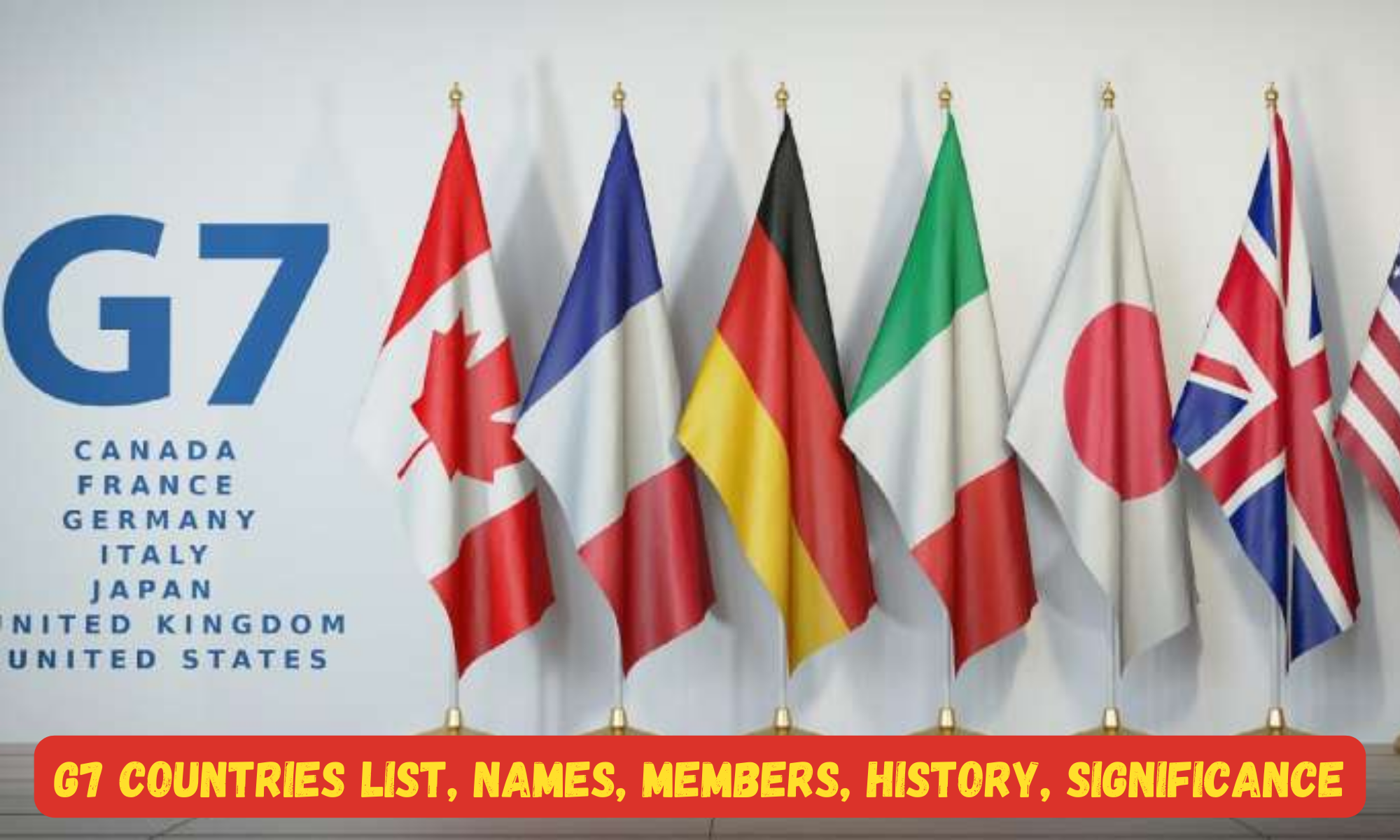G7 Countries Name List
The Group of Seven, commonly referred to as the G7, is an influential forum of some of the world’s leading industrialized democracies. It serves as a platform for discussions and coordination on global economic issues, security matters, and other pressing challenges. In this article, we will explore the G7 countries list, their names, members, delve into the history of the group, and discuss its significance in today’s global landscape.
G7 Countries List and Members:
The G7 consists of seven member countries, which are:
| G7 Countries | ||
| S. No. | Country | Description |
| 1. | Canada | As one of the largest countries in the world, Canada is known for its vast natural resources and strong economic ties with its G7 counterparts. |
| 2. | France | Renowned for its rich cultural heritage, France holds a significant position in the European Union and has been an influential member of the G7 since its inception. |
| 3. | Germany | Germany is a powerhouse in the European Union and has the largest economy in Europe. Its participation in the G7 contributes to global economic stability. |
| 4. | Italy | With its historical and cultural significance, Italy brings a unique perspective to the G7 discussions. It is known for its rich artistic heritage and is a major player in the European economy. |
| 5. | Japan | As one of the world’s largest economies, Japan plays a crucial role in the G7. It is at the forefront of technological advancements and is known for its innovation. |
| 6. | United Kingdom | The United Kingdom, comprising England, Scotland, Wales, and Northern Ireland, has a strong global presence. It is recognized for its historical and economic contributions. |
| 7. | United States | As the world’s largest economy and a global superpower, the United States wields significant influence within the G7. It plays a crucial role in shaping the global economic and political landscape. |
History of the G7
The origins of the G7 can be traced back to the early 1970s when finance ministers and central bank governors from six leading industrial nations—the United States, United Kingdom, West Germany, France, Italy, and Japan—began meeting informally to discuss economic issues. In 1975, this informal gathering expanded to include heads of state or government, leading to the formation of the G7.
Canada joined the group in 1976, and since then, the G7 has been an influential platform for cooperation and coordination among its member countries. The group initially focused on economic issues but gradually expanded its scope to include discussions on global security, environmental challenges, and other pressing global concerns.
Objective of G7
The G7, originating from an impromptu assembly of finance ministers in 1973, has evolved into a prominent forum for addressing critical global challenges. Its primary objective is to facilitate formal and high-profile discussions among member nations concerning vital issues spanning trade, security, economics, and climate change. Through coordination and collaboration, the G7 aims to develop solutions that contribute to global stability, prosperity, and sustainable development.
Significance of the G7:
The G7 holds immense significance due to several reasons:
1. Economic Influence: Collectively, the G7 member countries represent a significant share of the global economy. Their combined GDP accounts for a substantial portion of the world’s total economic output. As such, decisions made within the G7 can have far-reaching implications for global economic stability and growth.
2. Policy Coordination: The G7 provides a forum for member countries to coordinate their policies and address common challenges. By sharing knowledge, experiences, and best practices, they can align their efforts and achieve collective solutions to complex problems.
3. Global Governance: The G7 plays a vital role in global governance, shaping international policies and influencing decision-making processes. As leading industrialized democracies, the G7 countries often have a significant impact on issues such as trade, climate change, security, and global health.
4. Diplomatic Relations: The G7 serves as a platform for diplomatic engagements among member countries. Leaders have the opportunity to hold bilateral meetings, foster relationships, and strengthen international cooperation on various fronts.
5. Crisis Management: The G7 has historically played a crucial role in managing global crises. Whether it is responding to
financial downturns, geopolitical tensions, or public health emergencies, the G7 provides a platform for swift coordination and collaborative efforts to address and mitigate the impact of these crises. The G7’s collective expertise and resources enable effective crisis management and response.
6. Influence on Global Agenda: The G7 has the power to set the global agenda by discussing and prioritizing pressing issues. The topics discussed within the G7 often find their way into international forums, shaping the discourse and policies on a global scale.
7. Symbolic Importance: The G7 represents a select group of influential and prosperous nations, and its annual summit serves as a symbol of their collective power and influence. The presence of world leaders in the G7 summit highlights the significance of the forum and underscores the importance of multilateral cooperation in addressing global challenges.
G7 Countries Membership Requirements
There are no formal requirements for membership, but all participants are highly developed democracies. The combined GDP of the G7 represents over 50% of the world’s economy, but they only account for 10% of the world’s population.
Important Facts About G7
- The G7 countries list consists of Canada, France, Germany, Italy, Japan, the United Kingdom, and the United States.
- As a forum of leading industrialized democracies, the G7 plays a crucial role in global governance, economic coordination, crisis management, and shaping the international agenda.
- Its member countries, with their economic might and political influence, hold significant responsibility in addressing global challenges and fostering international cooperation.
- The G7 continues to be a platform where important discussions take place, policies are coordinated, and collective action is pursued for the betterment of the global community.
- Initially known as the “Group of Five,” the G7 was established in 1975 as an informal gathering of the heads of major industrialized nations.
- The idea for such a forum first surfaced before the oil crisis of 1973, with senior financial executives from the US, UK, West Germany, Japan, and France meeting to discuss economic issues of the time.
- With the inclusion of Canada in 1976, the inaugural meeting of the G7 was held in Puerto Rico that same year, where they agreed on an economic strategy and initial countermeasures to address the global recession and the failure of the Bretton Woods system.
- The European Economic Community was later invited by the UK in 1981, and Russia joined the group in 1997, forming the G8, which symbolized cooperation between East and West after the fall of the Soviet Union in 1991.
- Matteo Renzi announced on July 4, 2016 that Taormina was chosen as the G7’s location for their annual meeting.
- The G7 is an informal group of seven industrialized, democratic countries that meet once a year to discuss various global issues. These countries consist of the United States, Canada, France, the United Kingdom, Germany, Italy, and Japan.
- India, along with the G7 nations, is a member of the G20, but the G7 lacks a formal constitution and permanent headquarters. Decisions made during these yearly summits are not legally binding.
G7 was created in 1975 by France, West Germany, Italy, Japan, the United Kingdom, and the United States to discuss important economic concerns. Canada joined as a member in 1976, and the first G7 summit was held in Puerto Rico that same year. The European Union has been a “non-enumerated” full member since 1981, and Russia briefly joined in 1997, changing the group’s name to G8. However, Russia was expelled in 2014 following its invasion of Crimea.



 Which Crop is known as the King of Oilse...
Which Crop is known as the King of Oilse...
 Which River is known as the Gold River o...
Which River is known as the Gold River o...
 MoSPI Launches New Logo and Mascot ‘Sank...
MoSPI Launches New Logo and Mascot ‘Sank...







